b-24
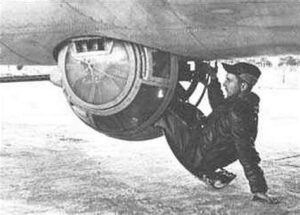
 There are many heroes is a war, and World War II is no exception. Because my dad, Allen Spencer served on a B-17, and was a Flight engineer and Top Turret Gunner, I have always had a special spot in my heart for the Flying Fortress. After all it is the plane that safely brought my dad back from the war so he could be my dad. Most people, who know anything about the B-17, know that the most dangerous station on the B-17 is the Ball Turret. In fact, the average life span of a ball turret gunner in battle is 12 seconds…seriously!! The bad thing for the ball turret gunner is that because it is a small space, the job goes to the smallest man in the group, and if there isn’t anyone who is 5’7″ or shorter, they have to find one. That is basically how Frank Perez ended up in that spot. It was very unexpected, because he trained in Biloxi, Mississippi at the B-24 training base, so it was expected that he would be assigned to a B-24.
There are many heroes is a war, and World War II is no exception. Because my dad, Allen Spencer served on a B-17, and was a Flight engineer and Top Turret Gunner, I have always had a special spot in my heart for the Flying Fortress. After all it is the plane that safely brought my dad back from the war so he could be my dad. Most people, who know anything about the B-17, know that the most dangerous station on the B-17 is the Ball Turret. In fact, the average life span of a ball turret gunner in battle is 12 seconds…seriously!! The bad thing for the ball turret gunner is that because it is a small space, the job goes to the smallest man in the group, and if there isn’t anyone who is 5’7″ or shorter, they have to find one. That is basically how Frank Perez ended up in that spot. It was very unexpected, because he trained in Biloxi, Mississippi at the B-24 training base, so it was expected that he would be assigned to a B-24.
Frank expected to be assigned to a B-24 crew but due to the “needs of the service,” Frank was assigned to the Lieutenant John J Connolly crew of a B-17 Flying Fortress. The B-17 crew already had a flight engineer, so Frank was selected for the ball turret gunner position. Knowing what I know about the ball turret gunner and knowing that anyone who knew about the B-17 also knew about the life span of a ball turret gunner, I’m quite sure that Perez instantly felt just a little bit sick to his stomach…a feeling that would be justified later. Perez had to fly for a time with a different crew while his crew finished some training. Then, he contracted pneumonia, and he was down for a month.
Finally, on July 28, 1944, Perez started flying with his crew again. Their target was the synthetic oil and ammonia plant at Merseburg, Germany. As we know, all combat missions were dangerous, but for Perez, this particular mission to Ludwigshaven, Germany, would really test his faith. Ludwigshaven was the site of large marshalling (railway) yards and a railroad depot. When the bombing run was completed, the B-17s headed back to their base in England. One of the most dangerous parts of a bombing run is maneuvering through the anti-aircraft guns with their flak. Frank’s B-17 was hit by flak and began tumbling and rolling out of control as it quickly lost altitude from about 30 thousand feet. The plane was still over Germany, and Perez could not get out of the ball turret due to the centrifugal force created as the plane fell from the sky. All he could do is watch in horror as the ground got closer and closer. He called the pilot on the intercom. No answer. Then he called “anyone.” No answer. He had to assume that he was the only survivor left…and that would not be for long.
Perez was sure that his life was over, so he started to pray. He prayed, “Well, God, if this is the way it has to be, let it be.” It was a noble prayer, but as he said, “I was under tension and wanted to live. But when I said that, at that instant, everything was just as peaceful as it can get. [I] had my whole life flash before me…from the time I was a little kid to that moment. I mean just like a movie but going like that [he snaps his fingers]. It’s hard to explain…like if you get killed, so what…you just don’t care.” It was his way of resigning himself to his fate and, then…the B-17 pulled up.
The flak might have knocked them out, and some were likely injured, but they were alive. The plane flew in at treetop level with only two of the four engines working. The crew, in an effort to lighten the load, began throwing unnecessary equipment and supplies out of the plane. Perez was still in the ball turret, as he had been for the entire mission. Finally, he saw the White Cliffs of Dover on the English coastline and knew that they 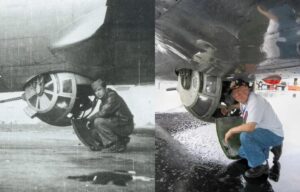
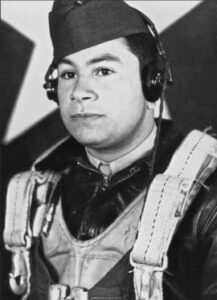 were going to make it. The B-17 was able to land at a B-24 base in England, where it was repaired.
were going to make it. The B-17 was able to land at a B-24 base in England, where it was repaired.
After completing his required combat missions, Perez was discharged and sailed home to the United States. He was back in the US before December 16, 1944. Surviving the ball turret was the saving grace for Perez, who went on to live a long and fruitful life. He died January 16, 2015, two days after his 91st birthday.
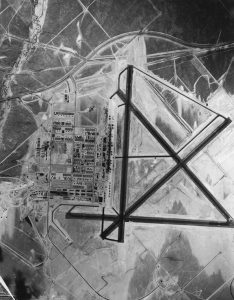
 Prior to December 7, 1941, the United States had signed a Proclamation of Neutrality. They did not want to get pulled into World War II, any more than they had World War I and any of the other wars they were involved in. Still, I think everyone knew that it was inevitable…even before the Japanese attack. Early on the Sunday morning of December 7, 1941, the Japanese attack on Pearl Harbor, Hawaii, and almost simultaneously at other locations in the Pacific, would end any continued semblance of neutrality, and the United States prepared for war. The response to the attack was quick and decisive. The US Army Air Force (USAAF), under the command of Major General Henry Harley “Hap” Arnold was authorized to equip, man, and train itself into the world’s most powerful air force, and to do so quickly. The first order of business was to establish air force bases. By early 1942, the USAAF had committed to building scores of air bases across the United States. Everyone wanted to help, so a Chamber of Commerce delegation from Casper, Wyoming, traveled to Washington DC, to lobby for one of the proposed air bases. According to Joye Kading, longtime secretary at the Casper Army Air Base, they marketed the “zephyr wind” that whips around the western end of Casper Mountain as part of what made it a perfect location. The USAAF agreed.
Prior to December 7, 1941, the United States had signed a Proclamation of Neutrality. They did not want to get pulled into World War II, any more than they had World War I and any of the other wars they were involved in. Still, I think everyone knew that it was inevitable…even before the Japanese attack. Early on the Sunday morning of December 7, 1941, the Japanese attack on Pearl Harbor, Hawaii, and almost simultaneously at other locations in the Pacific, would end any continued semblance of neutrality, and the United States prepared for war. The response to the attack was quick and decisive. The US Army Air Force (USAAF), under the command of Major General Henry Harley “Hap” Arnold was authorized to equip, man, and train itself into the world’s most powerful air force, and to do so quickly. The first order of business was to establish air force bases. By early 1942, the USAAF had committed to building scores of air bases across the United States. Everyone wanted to help, so a Chamber of Commerce delegation from Casper, Wyoming, traveled to Washington DC, to lobby for one of the proposed air bases. According to Joye Kading, longtime secretary at the Casper Army Air Base, they marketed the “zephyr wind” that whips around the western end of Casper Mountain as part of what made it a perfect location. The USAAF agreed.
In March 1942, the US Army Corps of Engineers leased the old Casper City Hall at Center and Eighth streets in downtown Casper, in preparation for the construction of the new Army Air Base at Casper. The site they selected was a high, flat, sagebrush-covered terrace located nine miles west of town on US Highway 20-26 and adjacent to the Chicago, Burlington and Quincy railroad. After the war, the site became the Natrona County Municipal Airport and the land and all buildings became county property…later the name was changed to Casper-Natrona County International Airport when the airport achieved international status. The Casper Air Base was built in record time. Ground was broken in April, and six months later, on September 1, 1942, the base was officially opened. B-17 bomber crews began their Combat Crew Training School at the facility that consisted of four mile-long runways and around 400 buildings. With in six months, in the spring of 1943, the base transitioned from B-17 to B-24 crew training. Kading said, “The base was built to accommodate 20,000 men to be trained. They would come out there, and they were trained to do the last of their training in the B-17s and the B-24s because they could go around the east end of Casper Mountain and hit the zephyrs…our famous west winds…to take them right up to the sky.” By war’s end, almost 18,000 men had been trained at the Casper Army Air Base.
Not all was fun and games in learning to fly. Pilots did face risks too, as they gained experience. Flying over mountains can bring downdrafts, and turbulence, and it can make for a risky flight for the inexperienced pilot. The base had it’s share of accidents. Kading said, “The fellows hit something in the wind that they didn’t know how to handle, and they would have a plane wreck and they were lost. A lot of our pilots were in training, and we had some of our planes [that] were wrecked in other states. The soldiers’ bodies were then shipped back home to their families.” In the war years, the base was almost a third of the size of the city that was it’s host. On any given day, the base had an average of approximately 2,250 Army Air Force personnel and 800 civilians. I’m told by my Aunt Sandy Pattan that some of my aunts were among the civilians who worked there. The training class sizes varied, with as many as 6,000 in training during peak times. The men arrived in Casper by train, in newly assembled crews, each consisting of two pilots, a navigator, a bombardier, a radioman, flight engineer, and four gunners, to begin a strict regimen of training.
In one record-setting month, crews flew more than 7,500 hours at Casper Army Air Base. The remains of these activities are scattered across the high plains of Wyoming in the form of spent .50-caliber bullets, shells and links, 100-pound practice bomb fragments, and the wreckage of more than 70 aircraft. At the height of training, more than one million .50-caliber rounds and one thousand 100-pound training bombs would be expended per month. Now that, for some reason, amazes me. To think of spent bullets and parts of bombs or planes just lying around in the plains of Wyoming…just amazing, but of course, logical. One hundred forty Casper Army Air Base aviators perished in 90 plane crashes in training. Many more died later in combat. One hundred forty Casper Army Air Base aviators perished in 90 plane crashes between September 1942 and March 1945. Most of the crashes were in Wyoming, but many occurred out of state when the fliers were on longer training flights.
Most of the soldiers who came to Casper were not from Wyoming, but they embraced Wyoming and felt like their time in Casper was very special. Not only did Casper Army Air Base become a part of them forever, but they became a part of it too. Some of the soldiers wanted to show just how special the base was to them, so they decided to paint murals at the enlisted men’s club. Casper artist and art historian, Eric Wimmer, later researched the series of murals that depicted Wyoming’s history, and found that they were painted by some of the soldiers. Wimmer said, “They served for a short time, and then many soldiers were stationed at another base or sent overseas to fight in the war. This became the driving inspiration behind the concept [Cpl.] Leon Tebbetts developed for painting a set of murals in the Servicemen’s Club. He planned to give these temporary residents a history lesson on the state of Wyoming before they left.” The work began in October 1943, Tebbetts and three other soldiers with art backgrounds…JP Morgan, William Doench, and David Rosenblatt…started the series of 15 murals that included American Indians, travel on the trails in pioneer days, and other historic subjects. The murals are still there to this day.
The Casper Army Air Base closed in 1945, when the war ended. Today, the site of the old bomber base is largely intact with 90 of the original buildings still standing, including all six of the original hangars. I know that one of the barracks was moved to North Casper, because my grandfather, George Byer bought it to expand his small house to accommodate his large family of nine children. I remember playing back in that large room as a child. Visitors to the Wyoming Veterans Memorial museum in the base’s former Servicemen’s Club encounter a variety of stories: a gunnery instructor who gained his experience against the Japanese fleet during the Battle of Midway; a base commander who was known as the best machine gunner in the world; and a bomber navigator who was blown out of his B-17 and held prisoner in Germany. In addition, there are accounts of the 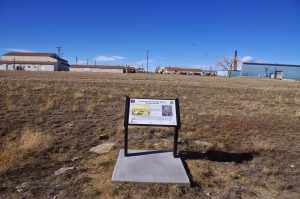
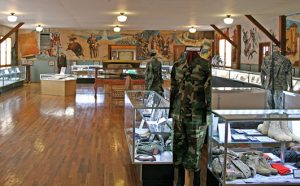 tragedy of the Casper Mountain bomber crash that I am certain was the crash that my then 8-year-old mother, Collene (Byer) Spencer witnessed. The base was also witness to the adventures of renowned test pilot Chuck Yeager, and saw the time that comedian Bob Hope paid a visit to the soldiers stationed there.
tragedy of the Casper Mountain bomber crash that I am certain was the crash that my then 8-year-old mother, Collene (Byer) Spencer witnessed. The base was also witness to the adventures of renowned test pilot Chuck Yeager, and saw the time that comedian Bob Hope paid a visit to the soldiers stationed there.
 Whenever I come across a book about World War II, and especially about a B-17 Bomber, I want to read it. That subject holds my interest mostly because my dad, Allen Spencer was a top turret gunner and flight engineer on a B-17 bomber stationed at Great Ashfield, Suffolk, England. Lately, I have been “reading” by way of Audible.com, and I must say that having a book read to you, allows you to sit back and enjoy it as if you were watching it unfold before your very eyes. So, when I came across a book called The Lost Airman written by Seth Meyerowitz, I knew I had to hear about it. As the true story began, I found that Arthur Meyerowitz (Seth Meyerowitz’ grandfather) could have been my own dad…at least to the extent that both of them were in the Eight Air Force stationed in England. Arthur was assigned to a B-24 Liberator. At first their experiences were probably almost identical. Arriving at his base, Arthur heard the men who had been there a while, tease the newcomers with things like “You’ll be sorry you came here” or “Look, fresh meat.” I can only imagine how that kind of thing must have felt to the new and often very young airmen…like a swift kick in the gut!! Then the book went on to tell how the airmen felt on their first mission, when no one could eat breakfast, because of the churning in their stomach. Arthur was the flight engineer and top turret gunner, just like my dad had been. It was the job of the flight engineer to check the plane over to ensure that it was fight worthy, and report to the captain. Arthur found problems with their plane, Harmful Lil Armful, and told his captain it needed repairs, but his captain wouldn’t hear of it. He was close to going home, and wanted his last mission out of the way, and besides what did this “newbie” know. He was only on his second mission, and he was filling in for someone else. So, they took off…a catastrophic decision.
Whenever I come across a book about World War II, and especially about a B-17 Bomber, I want to read it. That subject holds my interest mostly because my dad, Allen Spencer was a top turret gunner and flight engineer on a B-17 bomber stationed at Great Ashfield, Suffolk, England. Lately, I have been “reading” by way of Audible.com, and I must say that having a book read to you, allows you to sit back and enjoy it as if you were watching it unfold before your very eyes. So, when I came across a book called The Lost Airman written by Seth Meyerowitz, I knew I had to hear about it. As the true story began, I found that Arthur Meyerowitz (Seth Meyerowitz’ grandfather) could have been my own dad…at least to the extent that both of them were in the Eight Air Force stationed in England. Arthur was assigned to a B-24 Liberator. At first their experiences were probably almost identical. Arriving at his base, Arthur heard the men who had been there a while, tease the newcomers with things like “You’ll be sorry you came here” or “Look, fresh meat.” I can only imagine how that kind of thing must have felt to the new and often very young airmen…like a swift kick in the gut!! Then the book went on to tell how the airmen felt on their first mission, when no one could eat breakfast, because of the churning in their stomach. Arthur was the flight engineer and top turret gunner, just like my dad had been. It was the job of the flight engineer to check the plane over to ensure that it was fight worthy, and report to the captain. Arthur found problems with their plane, Harmful Lil Armful, and told his captain it needed repairs, but his captain wouldn’t hear of it. He was close to going home, and wanted his last mission out of the way, and besides what did this “newbie” know. He was only on his second mission, and he was filling in for someone else. So, they took off…a catastrophic decision.
This was where and similarities between Arthur’s experiences, and those of my dad ended, because my dad was not shot down like Arthur’s plane was. At the point Arthur’s plane was going down, his pilot and co-pilot showed incredible cowardice, and abandoned the plane first…something that was just not done. Arthur tried to 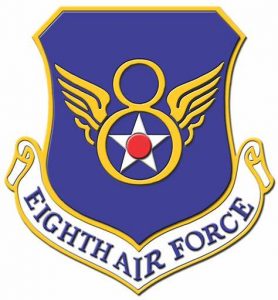 make sure everyone was off, but in the end, one man was stuck and injured. He told Arthur to go and take the newcomer with him, but the newcomer wouldn’t go. He fought Arthur, and actually kicked him off the plane, physically. As Arthur fell, he was sickened by the fact that his pilot and co-pilot jumped first, and that his friends would not be coming home. The pilot and co-pilot spent the rest of the war in a prison camp, but the outcome for Arthur was different, and in fact, miraculous, in more ways than one, because Arthur was not only an airman in the US Army Air Forces, but he was also a Jewish man facing the Nazis in World War II…a perilous place to be.
make sure everyone was off, but in the end, one man was stuck and injured. He told Arthur to go and take the newcomer with him, but the newcomer wouldn’t go. He fought Arthur, and actually kicked him off the plane, physically. As Arthur fell, he was sickened by the fact that his pilot and co-pilot jumped first, and that his friends would not be coming home. The pilot and co-pilot spent the rest of the war in a prison camp, but the outcome for Arthur was different, and in fact, miraculous, in more ways than one, because Arthur was not only an airman in the US Army Air Forces, but he was also a Jewish man facing the Nazis in World War II…a perilous place to be.
It was at this point in the book that my interest in it changed, because this could have been the fate of my dad, had his plane been shot down, but it hadn’t. While the outcome for Arthur was better than that of his crew mates, he still went through a harrowing experience, as did those who helped him. Arthur came down in occupied France on December 31, 1943, and in his landing, he badly hurt his back. From that point on, Arthur came in contact with some of the most amazing people on earth in that or any other time. The French resistance network took Arthur in, and over the next six months, they slowly smuggled him and a British Airman out through Spain to the Rock of Gibraltar. These people did this with precision and secrecy. They knew that if they were caught, they would be killed, but they hated the Nazis, and would do anything to fight against the Nazi regime…right up to, and for some, including giving their lives. The chances they took and the hardships they faced…voluntarily, were so far above and beyond the call of duty, that it almost seemed like a fictional movie. You know, the kind where the good guys always win, and the bad guys always lose. Nevertheless, this wasn’t a fictional movie, and the lives lost were real, but Arthur  Meyerowitz was not among the lives lost. His was saved because of the selfless acts of so many people in the French Resistance. The story of Arthur Meyerowitz was, for me, so moving that in the end, I cried, and throughout the book, there were moments that I could hardly breathe with the tension of the situations they found themselves in. I felt bad to think it, but I was so thankful that my dad’s B-17 always made it home, and he never had to face the prison camps, or try to escape from a hostile nation. For Arthur, his escape was miraculous, and I believe it was because of the fervent prayers of his family and the undying faith of his mother, who believed that God would bring her son home…and God did.
Meyerowitz was not among the lives lost. His was saved because of the selfless acts of so many people in the French Resistance. The story of Arthur Meyerowitz was, for me, so moving that in the end, I cried, and throughout the book, there were moments that I could hardly breathe with the tension of the situations they found themselves in. I felt bad to think it, but I was so thankful that my dad’s B-17 always made it home, and he never had to face the prison camps, or try to escape from a hostile nation. For Arthur, his escape was miraculous, and I believe it was because of the fervent prayers of his family and the undying faith of his mother, who believed that God would bring her son home…and God did.

